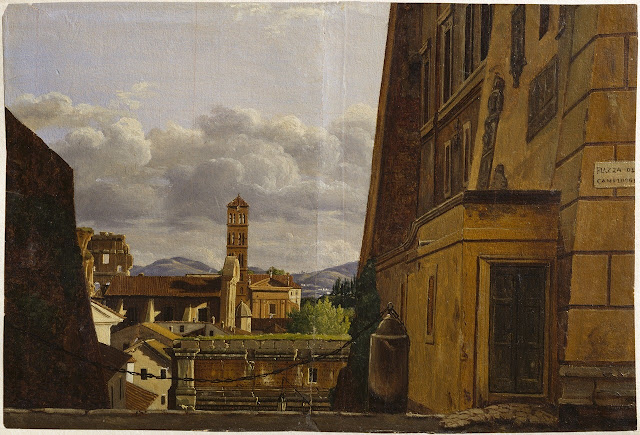 |
| Richard Bergh Sketch for The Knight and the Maid 1894 oil on canvas, mounted on panel Nationalmuseum, Stockholm |
 |
| Francisco Goya Truth, Time, and History before 1828 oil on canvas Nationalmuseum, Stockholm |
 |
| Johan Christian Dahl Princess Caroline Amalie sketching in Naples 1820 oil on paper, mounted on panel Nationalmuseum, Stockholm |
 |
| Simon Denis Study in the Roman Campagna ca. 1800 oil on cardboard Nationalmuseum, Stockholm |
"During the eighteenth and nineteenth centuries, whether en route to Rome for the first time or making an excursion from the city as a seasoned resident, all who traversed the campagna did so in a state of heightened emotion and imaginative excitement. Prior familiarity with a combination of classical texts and the idealised landscape imagery of the seventeenth century established an expectation that the campagna would reveal itself to be a suitably picturesque and poetic setting for the historic scenes which had been enacted and imagined within its expanses. Encountering the contemporary reality of a bleak expanse of landscape provoked various kind of reflection – consternation, bewilderment, denial. . . . However, an important aspect of the complex of ideas and images associated with the campagna is its special place in the history of art as the site of the creation of a new form of landscape painting. In the seventeenth century the campagna became endowed with a further form of cultural prestige through the belief that it was here that Claude Lorrain and Nicolas Poussin discovered the inspiring raw material out of which they created ideal landscape painting. This association was based on an idea of Claude in particular inhabiting the landscape, savouring and absorbing its beauties, and translating them into pictorial form. This mythologisation was to be tenaciously influential on conceptions of the nature of the Roman landscape and how it was to be represented."
– Richard Wrigley, from The Roman Campagna Revisited, published in Tate Papers (Spring 2012)
 |
| Thorald Læssøe View towards the Forum Romanum from the Colosseum 1848 oil on canvas Nationalmuseum, Stockholm |
 |
| Gustaf Söderberg View from Piazza di Campidoglio, Roma before 1875 oil on paper Nationalmuseum, Stockholm |
 |
| Otto Wallgren Burrhus, Nero's Tutor, prostrating himself before his Sovereign Lord 1816 oil on canvas Nationalmuseum, Stockholm |
 |
| Mårten Winge Loki and Sigyn 1863 oil on canvas Nationalmuseum, Stockholm |
In Norse mythology the god Loki, brother of Odin, is the trickster and shape-shifter. After playing a prank that leads to the death of another god, Loki is chained to an underground rock in punishment. A serpent is suspended above him, releasing drops of poison onto his head. Loki's wife Sigyn stands by, holding out a bowl to intercept the poison. When the bowl is full, she must remove it for a moment in order to empty it. The drops of poison that then reach Loki's head cause him to writhe in pain. His struggles generate earthquakes. Swedish painter Mårten Winge composed this image in Rome, hiring a local figure-model for the god – at a time when Roman models were generally agreed to be superior to all others. The model's upraised right hand would have been holding a rope for support. The figure of Sigyn, by contrast, assumes a pose that no model could sustain for more than a few minutes, and appears to have been based on a draped mannequin.
 |
| Ferdinand Hartmann Portrait of Friedrich von Matthisson ca. 1800-1810 oil on canvas Nationalmuseum, Stockholm |
 |
| Uno Troili Portrait of Ann Lovisa Lagerhjelm 1851 oil on canvas Nationalmuseum, Stockholm |
 |
| Hugo Salmson Portrait of Mademoiselle Pourtalès 1880 oil on canvas Nationalmuseum, Stockholm |
 |
| Eugène Jansson Motif from Timmermansgatan 1899 oil on canvas Nationalmuseum, Stockholm |
 |
| Hjalmar Sandberg Motif from Vichy ca. 1877-79 oil on canvas Nationalmuseum, Stockholm |
 |
| Frants Böe Yellow Roses 1885 oil on canvas Nationalmuseum, Stockholm |
 |
| Berthe Morisot In the Bois de Boulogne before 1880 oil on canvas Nationalmuseum, Stockholm |